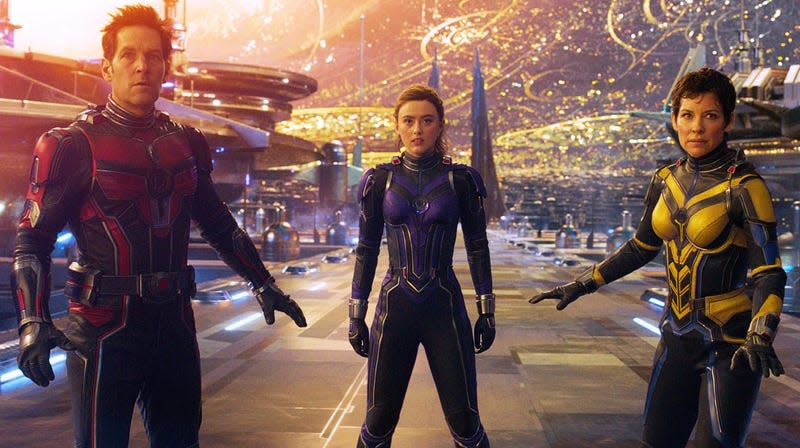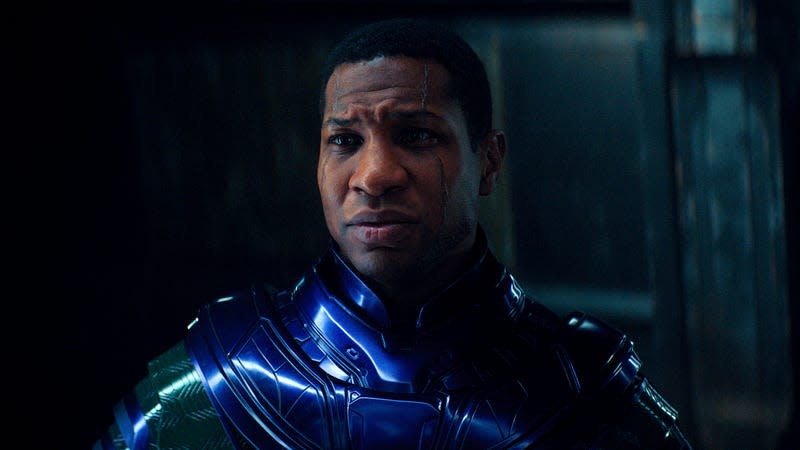Here's what to expect from Phase Five of the MCU

(From left) Paul Rudd as Scott Lang/Ant-Man, Kathryn Newton as Cassie Lang, and Evangeline Lilly as Hope Van Dyne/Wasp
As the Marvel Cinematic Universe closes out Phase Four with Black Panther: Wakanda Forever—and with the TV one-off, The Guardians Of The Galaxy Holiday Special, still to come before the month’s end—the current MCU evokes publishing forerunner Marvel Comics as the 1970s were winding down: more sprawling than ever, with a diverse array of characters, all interconnected to certain degrees, yet not quite as cohesive in its meta-narrative.
But that all seems prime for change as the Marvel heroes, and a few antiheroes, take their first steps into Phase Five.
Read more
In the first decade of the comic book Marvel Universe during the 1960s, creators Stan Lee, Jack Kirby, Steve Ditko, and Roy Thomas revolutionized the industry with a flood of fresh, spectacularly powered characters saddled with down-to-Earth problems, neuroses, and anxieties. They used storytelling styles that broke every traditional mold, making for an epic period of discovery, which was later replicated to some extent when the MCU brought its top-tier characters to the big screen.
By the 1970s, Marvel was riding high on its laurels but not resting on them, pushing into new genres and trends—horror, martial arts, blacksploitation, feminism, underground comix styles, and more—and even quirkier new characters emerged. Everything was on the storytelling table, from the biting socio-political commentary of Steve Englehart’s Captain America to the cosmic questing of Jim Starlin’s Warlock to the empowered adventures of superheroines like Ms. Marvel, She-Hulk, and Spider-Woman. And while any Marvel character could, and often did, show up in another hero’s storyline, the Marvel Universe didn’t seem quite as close-quartered and chummy as it did when most of the characters were superheroing in or near Manhattan.
The world had rightly gotten bigger, and better populated, but it wouldn’t be until the 1980s—after the ascent of the X-Men, which amped up the soap opera elements and tight-knit continuity of superhero storytelling, and the smash success of early crossover events like The Contest Of Champions and Secret Wars—that the Marvel Universe began to feel more cohesive than ever, with readers sensing that every new title was again part of a greater narrative mosaic.
New characters assemble
The MCU had already accomplished that sense of “must-see” cohesiveness in its build-up to Avengers: Infinity War and Avengers: Endgame, but in Phase Four, the focus has turned largely inward, especially with the advent of breakout TV series on Disney+ that introduced or reintroduced a small army of new characters and genre-samples.
All the while some of the MCU’s remaining leading lights—Spider-Man, Thor, Doctor Strange, and Loki—have been dropping breadcrumbs constituting the Multiverse Saga’s first act. As a result, the MCU has seemed decidedly bigger and broader than ever, but also—especially for fans hungering for a similar sense of drive that fueled Phase Three in particular—more splintered into self-contained fiefdoms than even its earliest pre-Avengers days.
But as Phase Five signals the beginning of the Multiverse Saga’s second act, expect a greater crossover cohesiveness as the MCU begins to assemble characters into intriguing configurations and reveal more of the stakes posed by the increasing bleed-over of alternate chronologies. Every announced Phase Five film and TV series to date spotlights characters the audience is already familiar with—even Blade and Daredevil, to a certain extent—so in most cases origin stories and explainers can be set aside in favor of advancing each protagonist’s place in the unfolding meta-story, even as we meet some new faces along the way.
The next big-screen arrival, Ant-Man And The Wasp: Quantumania, will likely go a long way toward uniting some of the multiversal elements introduced in Phase Four, specifically in terms of the saga’s presumed Big Bad, Kang the Conqueror, as played by Jonathan Majors: we’ve gotten a glimpse of one variant of Kang in Loki. This may not be the version that goes the distance, but certainly audiences will get a stronger sense of the stakes posed by the destabilizing multiverse and the big picture threat Kang(s) poses. Plus we’re getting a live-action Modok, Bill Murray as a mystery villain and The Good Place’s William Jackson Harper in an unspecified role. The second season of Loki will likely add even finer points to just where the Multiverse Saga is heading.

The Blip-aged Cassie Lang, now played by Kathryn Newton, will also play a key role in Quantumania, and it appears early on that, as in the comics, she’ll emerge as the size-changing Stature. Cassie is one of several youthful new superheroes now prominent in the ranks of the MCU, including Ms. Marvel, Ironheart, America Chavez, Hawkeye Kate Bishop, Thor’s foster daughter Love, maybe even a mystically powered Ned Leeds, and Wanda and Vision’s magically created twins.
Preparing for the Thunderbolts
Although Marvel has yet to formally announce a Young Avengers or Champions film, many of these characters have ties to one or both groups—as does a certain young variant of Kang, one that initially united the Young Avengers under the guise of Iron Lad (although a young variant of Loki might also make an intriguing uniter). It shouldn’t be surprising if more steps toward assembling a Gen Z Avengers-type team emerge in Phase Five or Six.
Speaking of super-teams, we already know the Thunderbolts are being assembled by the anti-Nick Fury, Contessa Valentina Allegra de Fontaine (Julia Louis-Dreyfus)—now intriguingly revealed as the ex-wife of Black Panther’s Everett Ross (Martin Freeman). We also know the team makeup: Black Widow Yelena Belova, U.S. Agent John Walker, Red Guardian, Taskmaster, Ghost, and the Winter Soldier (and maybe some surprise additions, like the Hulk’s newly revealed son Skaar, or Thor’s impending nemesis Hercules, who both seem suited to the team’s Dark Avengers vibe?).
With the Winter Soldier leading them, some of the groundwork setting up Thunderbolts will likely be laid in Captain America: New World Order, which promises a return of general-turned-politico Thaddeus “Thunderbolt” Ross, to be played now by Harrison Ford, who will almost certainly have a role in the team’s deployment—and given their shared surname and connection to Val, possibly a familial tie to Everett Ross. Between Captain America and Secret Invasion, expect plenty of international intrigue ahead in the MCU, as a temporary story reprieve from the Multiversal Saga.
As it seems that the MCU might be poised to explore both Young Avengers and Dark Avengers-style teams, audiences may be wondering what that means for the team-up prospects for legacy Avengers like Thor, Hawkeye, War Machine, Hulk, Cap Sam Wilson, Ant-Man, and Spider-Man, among others. Nothing in Phase Five suggests a reunion is imminent. What’s intriguing is that Phase Four put several members of the comics’ very popular, early ’90s lineup of Avengers—including Hercules, Sersi, and the Black Knight—on the MCU table; as well as additional characters with comic book Avengers bona fides, like Shang-Chi, She-Hulk and whatever superhero name Monica Rambeau settles on.

With James Gunn about to depart to shape the future of an entirely different comic book universe, the events of Guardians Of The Galaxy Vol. 3 could be the last hurrah for this particular assortment of characters, though some will likely soldier on elsewhere. But now that the Guardians have opened the spaceways to the cosmic corners of the MCU, there’s plenty to suggest that deeper explorations are on the way, thanks to toe-dips into the impending arrival of Adam Warlock. And recently seen allies like Pip the Troll and Thanos’ sibling, Starfox, promise that Warlock’s story—long viewed as one of Marvel Comics’ 1970s high points—will be arriving soon enough, likely tied into the next appearance of at least some of the Eternals.
An open door for Marvel horror
The supernatural side of the universe is also percolating on a number of fronts: with an MCU-retooled Blade coming and a strong reception to Werewolf By Night, the door to Marvel horror has been flung wide open, offering the promise of introductions to characters like Ghost Rider, Man-Thing, and maybe even—finally, fanboy speculators—Mephisto.
Another Marvel triumph from the ’70s—a rights-unentangled public domain character—The Tomb Of Dracula is also a possibility. Moon Knight and especially the forthcoming Agatha: Coven Of Chaos series are also ideally suited, with one foot planted in the mystic realm and one in the super-heroic realm, to help bridge the two, storywise. Wong’s increased—and always welcome—presence as the Sorcerer Supreme also bodes well for him to help build out the mystic side of Marvel—and let’s keep an eye out for Ned Leeds in the mix here, too.
There’s so much more to consider for Phase Five that will be revealed in due time: Will The Marvels and Secret Invasion expand the cosmic landscape of the Kree-Skrull conflict? Will Echo and Daredevil: Born Again revitalize a new urban street-level MCU? But perhaps the hottest burning question of the moment, one that Kevin Feige needs to seriously ponder, is exactly where, when, and with whom will Madisynn—you know the proper spelling by now—resurface in the MCU? It’s almost assuredly not where you thiiiiiiiiink…
More from The A.V. Club
Sign up for The A.V. Club's Newsletter. For the latest news, Facebook, Twitter and Instagram.

